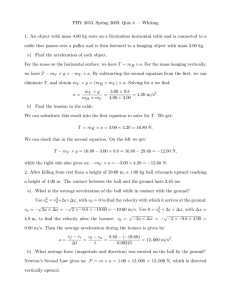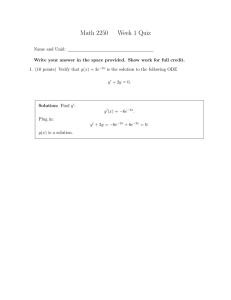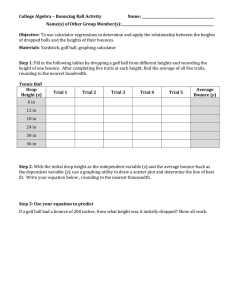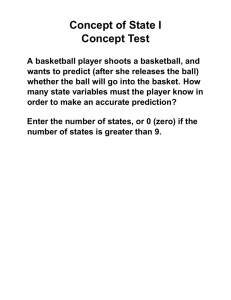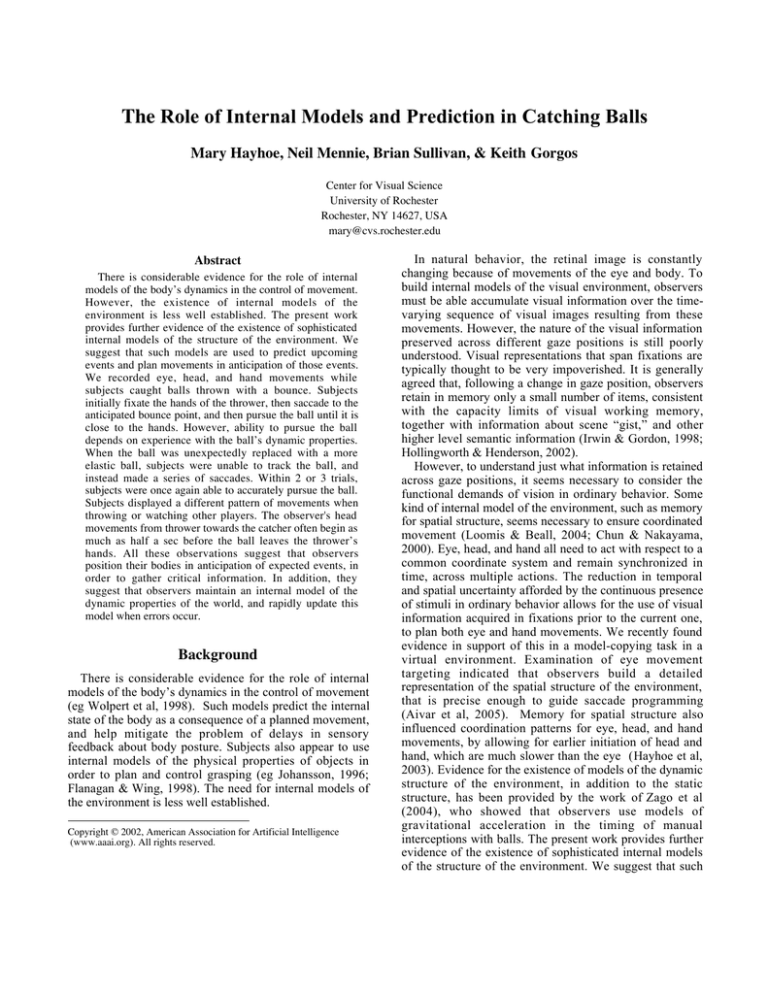
The Role of Internal Models and Prediction in Catching Balls
Mary Hayhoe, Neil Mennie, Brian Sullivan, & Keith Gorgos
Center for Visual Science
University of Rochester
Rochester, NY 14627, USA
mary@cvs.rochester.edu
Abstract
There is considerable evidence for the role of internal
models of the body’s dynamics in the control of movement.
However, the existence of internal models of the
environment is less well established. The present work
provides further evidence of the existence of sophisticated
internal models of the structure of the environment. We
suggest that such models are used to predict upcoming
events and plan movements in anticipation of those events.
We recorded eye, head, and hand movements while
subjects caught balls thrown with a bounce. Subjects
initially fixate the hands of the thrower, then saccade to the
anticipated bounce point, and then pursue the ball until it is
close to the hands. However, ability to pursue the ball
depends on experience with the ball’s dynamic properties.
When the ball was unexpectedly replaced with a more
elastic ball, subjects were unable to track the ball, and
instead made a series of saccades. Within 2 or 3 trials,
subjects were once again able to accurately pursue the ball.
Subjects displayed a different pattern of movements when
throwing or watching other players. The observer's head
movements from thrower towards the catcher often begin as
much as half a sec before the ball leaves the thrower’s
hands. All these observations suggest that observers
position their bodies in anticipation of expected events, in
order to gather critical information. In addition, they
suggest that observers maintain an internal model of the
dynamic properties of the world, and rapidly update this
model when errors occur.
Background
There is considerable evidence for the role of internal
models of the body’s dynamics in the control of movement
(eg Wolpert et al, 1998). Such models predict the internal
state of the body as a consequence of a planned movement,
and help mitigate the problem of delays in sensory
feedback about body posture. Subjects also appear to use
internal models of the physical properties of objects in
order to plan and control grasping (eg Johansson, 1996;
Flanagan & Wing, 1998). The need for internal models of
the environment is less well established.
Copyright © 2002, American Association for Artificial Intelligence
(www.aaai.org). All rights reserved.
In natural behavior, the retinal image is constantly
changing because of movements of the eye and body. To
build internal models of the visual environment, observers
must be able accumulate visual information over the timevarying sequence of visual images resulting from these
movements. However, the nature of the visual information
preserved across different gaze positions is still poorly
understood. Visual representations that span fixations are
typically thought to be very impoverished. It is generally
agreed that, following a change in gaze position, observers
retain in memory only a small number of items, consistent
with the capacity limits of visual working memory,
together with information about scene “gist,” and other
higher level semantic information (Irwin & Gordon, 1998;
Hollingworth & Henderson, 2002).
However, to understand just what information is retained
across gaze positions, it seems necessary to consider the
functional demands of vision in ordinary behavior. Some
kind of internal model of the environment, such as memory
for spatial structure, seems necessary to ensure coordinated
movement (Loomis & Beall, 2004; Chun & Nakayama,
2000). Eye, head, and hand all need to act with respect to a
common coordinate system and remain synchronized in
time, across multiple actions. The reduction in temporal
and spatial uncertainty afforded by the continuous presence
of stimuli in ordinary behavior allows for the use of visual
information acquired in fixations prior to the current one,
to plan both eye and hand movements. We recently found
evidence in support of this in a model-copying task in a
virtual environment. Examination of eye movement
targeting indicated that observers build a detailed
representation of the spatial structure of the environment,
that is precise enough to guide saccade programming
(Aivar et al, 2005). Memory for spatial structure also
influenced coordination patterns for eye, head, and hand
movements, by allowing for earlier initiation of head and
hand, which are much slower than the eye (Hayhoe et al,
2003). Evidence for the existence of models of the dynamic
structure of the environment, in addition to the static
structure, has been provided by the work of Zago et al
(2004), who showed that observers use models of
gravitational acceleration in the timing of manual
interceptions with balls. The present work provides further
evidence of the existence of sophisticated internal models
of the structure of the environment. We suggest that such
models are used to predict upcoming events and plan eye
movements in anticipation of those events.
The recent development of eye trackers mounted on the
head has allowed the study of eye movements over
extended tasks in natural settings, where a much wider
variety of natural coordinated behaviors is possible (Land,
2004; Hayhoe & Ballard, 2005). In the context of such
natural behaviors, eye movements are often made to a
location in a scene in advance of an expected event. For
example, Land and MacLeod (2000) measured eye
movements in cricket, and found that batsmen anticipated
the bounce point of the ball by a few hundred ms, and more
skilled batsmen arrived at the bounce point about 100 ms
earlier than less skilled players. These saccades were
always preceded by a fixation on the ball as it left the
bowler’s hand, showing that batsmen use current sensory
data in combination with learnt models of the ball’s motion
to predict the location of the bounce. This suggests that eye
movement patterns are shaped by learnt internal models of
the dynamic properties of the world.
In the present study, we followed up the observations of
cricket to see if similar anticipatory eye movements are
observed in conditions requiring less skilled performance.
Results
Catching
Similar to batsmen in cricket, when catching a ball,
subjects initially fixate the hands of the thrower, then
saccade to the anticipated bounce point, and then pursue
the ball until it is close to the hands. Average departure
time of gaze from the hands of the thrower was 61 ms after
the ball left the hands. (Between subjects standard error of
the mean was 15 ms.) Gaze then arrives at a point a little
above the anticipated bounce location an average of 53 ms
before the bounce (30 ms SEM). Subjects maintain gaze at
this location until the ball comes into the fovea, and then
make a smooth pursuit movement, maintaining gaze on the
ball until the catch. Since the minimum time to program a
saccadic eye movement is 200-250 ms, the saccade from
the hands to the bounce point must anticipate the release of
the ball. We plotted the landing points of the saccades
relative to the actual bounce point and found that they
clustered within about 5 deg laterally, and about 15 deg
vertically above the bounce point. This is shown in Figure
1. Thus subjects appear to be targeting a region just above
the bounce point, rather than the bounce point itself. This
Methods
We recorded eye, head, and hand movements while five
subjects caught balls thrown with a bounce. In one
condition, three participants stood in a triangular
formation, separated by about 3m, and threw a ball around
the circle. Monocular eye position of one of the
participants was recorded using an ASL501 infra-red
video-based eye tracker, mounted on the head. Calibration
was performed on 9 points on the plane of the floor.
Accuracy of the tracker is about 1 deg of visual angle. In
addition to the data stream giving eye position in the head
at 60 Hz, the eye-tracker also provides a 30 Hz video
record of the scene from the observer’s viewpoint, from a
camera mounted on the head-band of the tracker. The video
record is useful for analyzing the timing of the eye
movements with respect to events in the scene, such at the
point in time at which the ball bounces. Head and hand
position were recorded at 60 Hz using three Polhemus
Fastrack magnetic 6 degree-of-freedom position sensors,
one attached to the head-band of the eye-tracker, and the
others mounted on the back of each hand.
Initially, subjects threw a tennis ball ten times, in the
same order, around the circle of three participants. Each
throw was performed with a single bounce approximately
mid-way between the participants. One of the throwers
then changed the ball without warning, to one with greater
elasticity (bounciness). This ball was then thrown for
another 10 times.
The location and timing of the eye movements were
analyzed frame-by-frame from the video records. (This is
laborious, but more reliable than automated coding in these
real-world settings.)
Fixation Relative to Bouncepoint when Catching
(degrees of visual angle)
25
20
15
10
5
0
-20
-15
-10
-5
0
5
10
15
20
-5
-10
Figure 1. Scatter plot showing landing point of saccades
anticipating the bounce for all subjects, plotted relative to the
bounce point.
presumably facilitates the subsequent tracking movement
by allowing time to capture the ball’s trajectory after the
bounce. The tight lateral clustering of the saccade landing
points relative to the bounce point suggests that subjects
are using information from the early part of the throw to
target the likely location of the bounce.
Adjusting to the Ball’s Dynamic Properties
Ability to pursue the ball depends on experience with the
ball’s dynamic properties. When the tennis ball was
unexpectedly replaced with a bouncier ball, subjects were
unable to track the ball, and instead made a series of
saccades. Within a few trials, subjects were once again able
to accurately pursue the ball. A crude evaluation of pursuit
accuracy was made by measuring the proportion of time
gaze was less than two ball diameters away from the ball,
in the period between bounce and catch. Improvement in
pursuit performance over 6 trials is shown in Figure 2,
which shows the proportion of time close to the ball
improving rapidly over the first three trial, close to the
performance level with the tennis ball. The ability to make
accurate pursuit movements in this context therefore
100 msec over the first 6 trials following the change from
tennis to bouncy ball. The earlier arrival of the eye at the
bounce point is accompanied by earlier departure from the
hands at the point of release. This is shown in Figure 4.
Thus subjects rapidly adjust timing of anticipatory
movements to the new ball dynamics.
When subjects watched one player throwing the ball to
the other player, they displayed a different pattern of
100%
90%
80%
70%
60%
50%
40%
Latency (ms)
%age of time gaze on Target
Watching
30%
20%
10%
0%
1
2
3
4
5
6
Trial Number
Figure 2. Pursuit performance as a function of trial number for
the tennis ball (top curve) and more elastic ball (bottom curve).
Error bars are +/- 1 SEM between subjects.
depends on knowledge of the dynamic properties of the
new ball. The adjustment in performance is quite rapid, and
uniform across subjects, suggesting that adjusting to such
changes in the environment is an important feature of
natural behavior. Note that two-dimensional retinal
velocities were quite variable, and ranged between 50 and
80 deg per sec, so it is unlikely that subjects improved
performance by simply increasing pursuit gain.
100
Latency (ms)
80
60
40
20
0
-20
1
2
3
4
5
6
Trial Number
Figure 3 Arrival time of gaze at the bounce point, relative to the
time of the bounce, as a function of trial number, for the tennis
ball (top curve) and bouncier ball (bottom curve). Error bars are
+/- 1 SEM between subjects.
The latency of the first saccade from hands to bounce
point also changed over the course of a few trials. Figure 3
shows arrival time at the bounce point advancing by about
0
-20
-40
-60
-80
-100
-120
-140
-160
-180
1
2
3
4
5
6
Trial Number
Figure 4. Departure time of gaze relative to release, as a
function of trial number, for the tennis ball (top curve) and
bouncier ball (bottom curve). Error bars are +/- 1 SEM between
subjects.
movements, first making a saccade to a point near the
bounce point, and then making a second saccade to the
catcher’s hands in anticipation of the catch. The timing of
these movements was well in advance of the ball. Gaze
departed the thrower’s hands 51 ms before the release of
the ball, and arrived at a point above the bounce point, 167
ms before the ball. Subjects then immediately made a
saccade to the catcher’s hands, arriving over 500 ms ahead
of the ball. Head movements from thrower towards the
catcher often begin as much as 500 ms before the ball
leaves the thrower’s hands. The location of the saccade in
anticipation of the bounce was scattered widely in the
region between thrower and catcher, as shown in Figure 5.
Presumably, the exact location of the bounce is not critical
to the subject as he/she is not catching the ball. Similarly,
there is typically no smooth pursuit between bounce and
catch. This suggests that the pursuit movement has some
function in providing information about the ball’s
trajectory when the subject must catch the ball, possibly
from the location of the eyes in the orbit during pursuit. On
some trials, watchers pursued the ball part of the way
between the bounce and the catch. This happened much
more frequently with the bouncy ball: 83% vs 22% in first
3 trials. This suggests that subjects use watching as well as
catching trials to learn the dynamic properties of bouncier
ball.
When subjects are themselves throwing the ball, yet
another pattern of fixations is observed. The subject fixates
model of the ball’s spatio-temporal path. The different
patterns observed for catching as opposed to throwing or
watching reveal that precise timing of the eye movements
was important for controlling the hands for catching.
Fixation Relative to Bounce Point When Watching
(degrees of visual angle)
25
20
15
10
Tennis Ball
Bouncy Ball
5
0
-10
-5
0
5
10
15
20
25
30
-5
-10
Figure 5. Scatterplot of saccade landing points in anticipation of
the bounce, relative to the bounce point, for all subjects while
watching a ball thrown from one player to another.
the ground mid-way between the bounce point and the
catcher, in advance of the throw. Gaze is transferred to the
catcher’s hands after the bounce, arriving 330 ms before
the ball.
Hand Movements
Examination of the hand movements also revealed
anticipation. The hands start to move together, up and
outwards from the body, in preparation for the catch, just
as the ball bounces or about 100ms before. This is
illustrated in Figure 6. The decrease in separation between
the hands in preparation for the catch, shown in the red
curve, begins a little later, about 100-200 msec after the
bounce. It is possible that this movement is also
programmed before the bounce, but the timing is consistent
with the fastest manual reaction times, so a reactive
response to the bounce cannot be ruled out. It appears
catching movements are synchronized to the timing of the
ball’s path between bounce and catch.
Conclusions
Retinal motion, stereo, and extra-retinal information
from pursuit eye movements have all been implicated in
catching balls (Oudejans et al, 1999; Rushton & Wann,
1999; Tresilian, 1999). We have demonstrated here that
prediction is also important. This is consistent with Land &
MacLeod’s (2000) observations that prediction of the
bounce point is important for intercepting the ball with the
bat in cricket. In the present study, anticipatory saccades,
head movements, and pursuit movements all reveal that
acquisition of visual information is planned for a predicted
state of the world. Such predictions must be based on a
stored memory representation of some kind. The precision
of the predictions reveals the quality of the information in
the stored memory. The spatial and temporal precision of
the anticipatory saccades, and the fine-tuning of these
movements following a change in the ball’s dynamic
properties indicate that subjects have an accurate internal
Figure 6. Hand position while catching, Zero indicates release of
the ball, Trials were normalized to the mean duration between
release and catch, The times of the bounce and catch are
indicated by the vertical lines. The red curve shows the horizontal
separation between the hands, the green curves show distance of
the hands from the body, and the blue curve shows vertical hand
position.
The present claim that subjects use internal models of
the ball’s motion to guide anticipatory movements is
consistent with the findings of Zago et al (2004) who found
that observers had an accurate internal model of the effects
of gravity on the motion of a target that they had to
manually intercept. Interestingly, when the (virtual) target
failed to conform to gravitational acceleration, subjects
adjusted their interception movements within five trials,
comparable to the time course of learning observed in the
present experiment. Zago et al argued that in their
experiment subjects were not adjusting the internal model,
but simply delaying the initiation of the hand movement.
The ability of subjects to accurately pursue the new ball in
the present experiment, despite variation in the 2D retinal
velocity, suggests that in the present experiment, subjects
are indeed learning an updated model, but we cannot argue
this case strongly on the basis of the current data.
Since subjects were unable to track the ball on the first
trial with the more elastic ball, prediction is necessary for
smooth pursuit. Smooth pursuit eye movements are thought
to be driven primarily by retinal velocity, although it has
also been recognized that pursuit performance improves
when the motion of the tracked object is predictable (Pola
& Wyatt, 1991). The present results reveal that prediction
is a critical component of naturally occurring pursuit
movements. The trial-to-trial variability in retinal velocity,
together with the overlap in the distributions of velocities
for the two different balls, suggest that the adjustment of
pursuit may be based on information about the expected
three-dimensional trajectory, rather than a simple increase
in pursuit gain.
In summary, the observations in the present experiment
suggest that observers maintain an internal model of the
dynamic properties of the world, and rapidly update this
model when errors occur. Rapid adjustment of performance
suggests that such prediction is a ubiquitous feature of
visually guided behavior.
Acknowledgements
Supported by NIH grants EY05729 and RR09283. Thanks
to Jennifer Semrau for assistance with the experiments.
References
Aivar, P., Hayhoe, M., & Mruczek, R. 2005 Role of spatial
memory in saccadic targeting in natural tasks. Journal of
Vision, 5, 177-193.
Chun, M., & Nakayama, K. 2000 On the functional role of
implicit visual memory for the adaptive deployment of
attention across scenes. Visual Cognition, 7, 65-82.
Flanagan, J. & Wing, A. 1997 The role of internal models
in motion planning and control: evidence from grip force
adjustments during movements of hand-held loads. J.
Neurosci 17, 1519-1528,
Hayhoe, M & Ballard, D. 2005 Eye Movements and
Cognition. Trends in Cognitive Science, 9, 188-194.
Hayhoe, M. et al. (2003) Visual memory and motor
planning in a natural task. J. Vis. 3, 49–63.
Hollingworth, A., & Henderson, J. M. 2002. Accurate
visual memory for previously attended objects in natural
scenes. Journal of Experimental Psychology: Human
Perception and Performance, 28, 113-136.
Irwin,D.& Gordon, R. 1998 Eye movements, attention, and
trans-saccadic memory. Visual Cognition, 5, 127-155.
Johansson, R. S. 1996 Sensory control of dextrous
manipulation in humans. In: Hand and Brain: the
neurophysiology and psychology of hand movements.
(Wing, A, Haggard, P, & Flanagan, J eds), pp381-414. San
Diego, Academic Press.
Land, M. (2004) Eye movements in daily life. In Chalupa,
L. and Werner, J., (eds) The Visual Neurosciences, 2, pp.
1357– 1368, MIT Press.
Land, M.F. and McLeod, P. 2000 From eye movements to
actions: how batsmen hit the ball. Nat. Neurosci. 3,
1340–1345.
Loomis, J. & Beall, A. 2004 Model-based control of
perception/action. In Vaina, L. et al (Eds) Optic Flow and
Beyond Netherlands: Kluwer 421-441.
Oudejans, R, Michaels, C, Davids, K, & Bakker, F. 1999
Shedding some light on catching in the dark: perceptual
mechanisms for catching fly balls. J Exp Psychol: Human
Perception & Performance 25, 531-542.
Pola, J. & Wyatt, H. 1991 Smooth Pursuit: response
characteristics, stimuli, and mechanisms. In Carpenter, R.
(ed) Eye Movements. Vision & Visual Dysfunction 8, Boca
Raton, CRC Press, 138-156.
Rushton, S & Wann, J. 1999 Weighted combination of size
and disparity: a computational model for timing a ball
catch. Nat Neurosci 2, 186-190.
Tresilian, J 1999 Visually timed action: time-out for “tau”?
Trends Cog Sci 3, 301-310.
Wolpert, D, Miall, C, & Kawato, M. 1998 Internal models
in the cerebellum. Trends in Cognitive Science, 2, 338-347.
Zago, M, Bosco, G, Maffei, V, Iosa, M, Ivanenko, Y, &
Lacquaniti, F 2004 Internal models of target motion:
expected dynamics overrides measured kinematics in
timing manual interceptions. J. Neurophysiol 91, 16201634.


